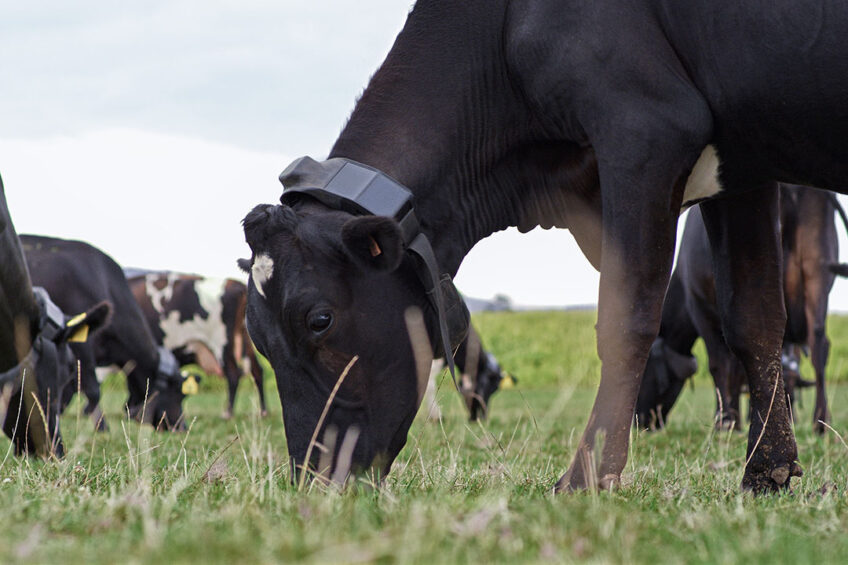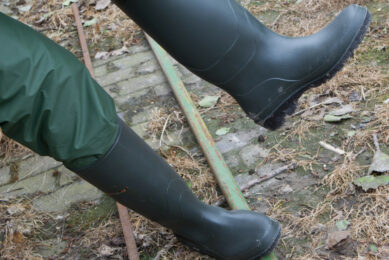New insights with collars transforming dairy farming

Machine learning with data from GPS-enabled collars will unlock insights in dairy farming that haven’t been observed thus far, expects Steve Crowhurst, business development manager of start-up Halter. Already there is huge interest by New Zealand dairy farmers in the collars made by Halter.
Crowhurst explains that currently, farmers usually rely on 1 or 2 people observing hundreds, and in some cases, thousands of cows, often just once a day, to spot sickness. “Adding to this challenge, cows are notoriously stoic, often hiding symptoms of poor health from potential predators,” he says.
“Halter sensors monitor a cow’s every movement 24/7, right down to the most subtle changes in behaviour. Our system uses this extensive data set to predict cow behaviour. Machine learning further optimises this data to make sure our cows are the healthiest in the world, which ultimately leads to improved productivity. We have a dynamic data set that’s constantly evolving.”

Outpacing competitors
Halter works with solar-powered, GPS-enabled smart collars that are fitted to each dairy cow and coupled with an app that allows farmers to remotely shift virtually fence and proactively monitor their cow’s health, feed, and behaviour.
A team of Halter fits a collar to each cow on a dairy farm and will gently train the herd. Its system is gradually introduced. Within 4 to 5 days cows can navigate around a farm using their collar. There is a huge interest in Halters’ collars in New Zealand. The start-up seems to be outpacing its competitors.
It is a substantial market, Crowhurst emphasises. “Our waiting list is long. But developing our product with some of the best farmers in New Zealand on some of the most advanced and efficient farm systems globally ensures we have a solid foundation to provide a revolutionary farm management system to farmers here and offshore.”
It is no surprise that much of the US$ 22.8 million in Series B funding that Halter recently raised will be used to scale up the company. The start-up is said to bring in about 100 people across the engineering, product, and go-to-market teams.
Dairy farmer well-being and impacts of automation
Studies in Canada and Sweden will hopefully lead to more research on the mental health benefits of using robotic milking systems and automated feeders. Here we look at what has been shown so far. Find out more…
“Much of the investment will be used to fulfill teams so we can deploy at scale,” says Crowhurst. “Currently, we are available on select farms in Waikato. In order to reach new territories, we need more hands on deck.”
In the longer term, Halter plans to enter overseas markets. But right now the company is solely focussed on New Zealand farms. “We have ambitious growth plans across New Zealand, and lots of amazing New Zealand farmers have been waiting patiently,” Crowhurst says. “I can’t speak on our plans offshore at this stage, but as you would imagine, many offshore locations would benefit from our technology.”
Unique, precision and flexibility on farm
Halter certainly seems to have the edge over the competition in New Zealand. According to Crowhurst Halter produces a different product than its competitors. “Unlike competing collars on the market, which almost all exclusively measure a cow’s activity, Halter has developed a patented technology called Cowgorithm,” he says.

“It uses artificial intelligence to guide individual cow movements, set virtual fences, and track well-being, offering greater precision and flexibility on farm. As far as we know, Halter is the only company providing this level of guidance that is also coupled with advanced activity monitoring.”
Currently, Halter offers farmers a suite of features: remote shift, virtual fencing, schedule shift, pasture management, and multiple mob management. Soon, the start-up will complete the rollout of heat detection and animal health monitoring. The system will alert farmers when a cow is in heat, calving, or lame before they show any visible signs.
“We’ve got more exciting tools in the pipeline for our farmers too, but they’re under wraps for now,” Crowhurst points out. “We’re able to roll out new features anytime as our collar software can be updated remotely while they’re in the field.”
WATCH THE HALTER VIDEO HERE
Welcome to the Future of Farming from Halter on Vimeo.
Reducing the risk of the labour shortage
One of the problems of dairy farms that collars also address is the challenge of labour shortage. “Our collars are automating some of the most time-consuming tasks in farming,” Crowhurst says. “Halter has essentially unlocked a new way for farmers to optimise their farm and reduce the risk of the labour shortage.”
Crowhurst says early feedback from farmers on 200 to 400 cow farms suggests they save up to 20 hours a week by simply eliminating the amount of time spent on the farm bike behind cows and setting up breaks in between milkings. “We’re enabling farmers to allocate feed on an exact level of m2 per cow or DM per cow lifting utilisation with a fraction of the workload. Farmers with Halter can significantly lift the number of cows managed per FTE.”
Also, the collars assist farmers in protecting the environment. “With a push of a button, cows are fenced away from vulnerable waterways to protect water catchments or away from any native growth,” Crowhurst says. “Halter’s pasture management feature also enables the smarter collection, synthesis, and actioning of data. This is coupled with virtual fencing to allow for more precise kg DM or pasture allocation per cow. Goodbye reels and standards. By better utilisation of grass on farm, Halter farmers can reduce their reliance on bought-in feed, lowering emissions.”

Halter uses a subscription model where farmers pay a monthly fee based on the number of cows they have and the level of functionality they choose. Crowhurst: “We’re in the process of quantifying the value of those features with our current group of farmers to ensure they have a great return on their investment with us.”
In the long term, Halter will introduce more technology to farmers, Crowhurst expects. “We are excited about the further advancements we’ll be bringing to our farmers in the future. Right now, however, we are focused on dairy cows.”
Join 13,000+ subscribers
Subscribe to our newsletter to stay updated about all the need-to-know content in the dairy sector, two times a week.










